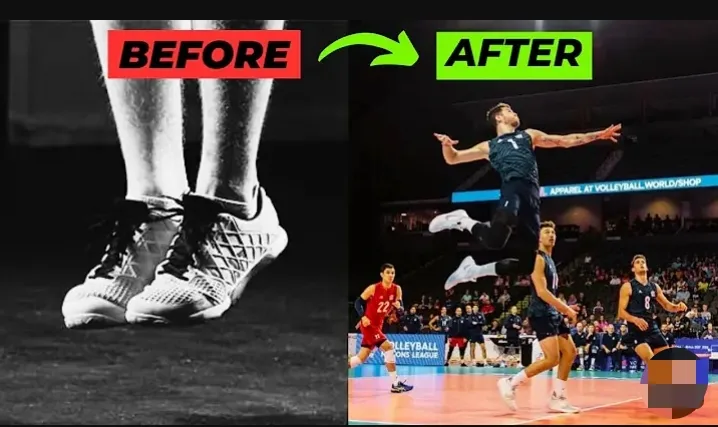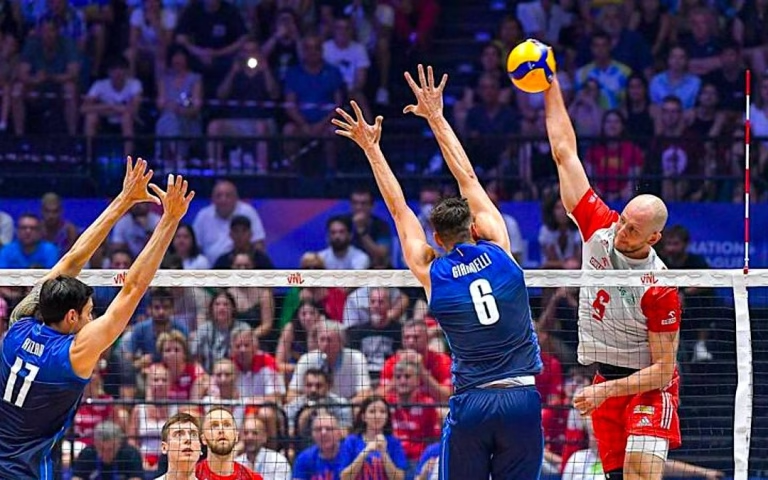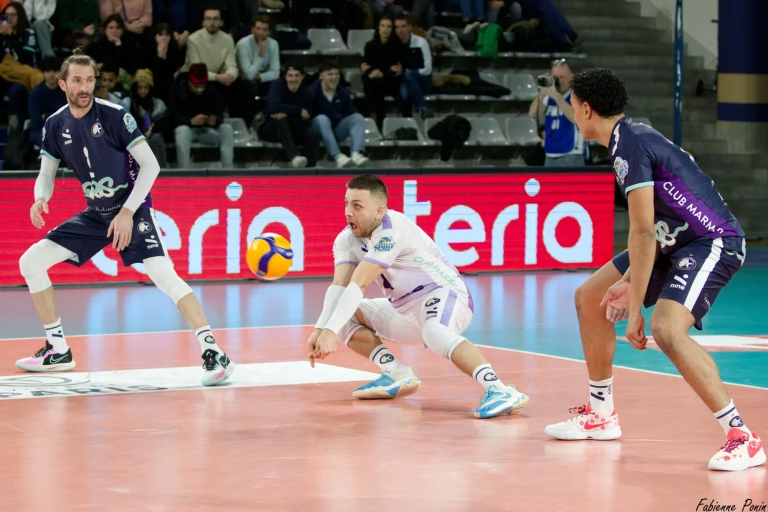Jumping high is a critical skill in volleyball, whether you’re executing an attacking spike, going up for a block, or delivering a powerful serve. Many players wonder how to jump higher in volleyball, knowing that improving their vertical jump can dramatically enhance their performance on the court. In this guide, we’ll explore the essential factors that contribute to jump height and provide actionable tips on how to jump higher in volleyball.
Understanding How to Jump Higher in Volleyball
If you want to learn how to jump higher in volleyball, it’s important to start with the basics: technique, strength, and consistency. These three pillars are the foundation of any successful vertical jump.
#1 Technique
Jumping isn’t just about sheer power—it’s about doing it the right way. Your jump technique can significantly impact how high you can go. A proper approach typically involves a two- or three-step run-up, followed by a strong push-off from both feet. While in the air, volleyball players should slightly arch their back during an attack or lean slightly forward when blocking. Mastering this technique is crucial to maximize your jump height.
Example: Consider how professional volleyball players like Karch Kiraly approach the net. They don’t just run and jump—they use a calculated approach, timing their steps perfectly, and utilizing a powerful push-off to reach their maximum height.
#2 Strength
To jump higher, you need strength—especially in your legs, back, and core. These muscle groups power your jumps, so regular strength training is essential. Exercises such as squats, lunges, and calf raises can significantly enhance your jumping ability by building the muscles that are most involved in the action.
Example: If you’re familiar with basketball, think of how much time players spend in the gym working on their leg strength to improve their vertical leap. The same principle applies to volleyball—stronger legs mean higher jumps.
See Also: 10 Best Volleyball Strength Exercises for Beginners
#3 Consistency
Improvement takes time, and jumping higher is no exception. It’s important to consistently practice your jump technique and strength exercises. This persistence will lead to gradual improvements in your vertical leap.
Exercises to Help You Jump Higher in Volleyball
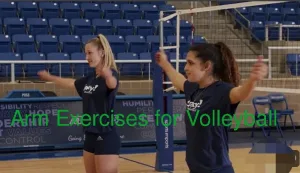
If you’re serious about learning how to jump higher in volleyball, incorporating specific exercises into your routine can make all the difference. Here are some exercises that target the key muscle groups involved in jumping:
1. Plyometrics
Plyometric exercises are crucial for developing explosive power, which is essential for a higher jump. Exercises like squat jumps, box jumps, and jumping lunges are effective in boosting your jump height.
Example: Imagine doing squat jumps where you explode upwards as soon as your feet touch the ground. This explosive movement mimics the action of a volleyball jump, helping you build the power needed for a higher leap.
See Also: 8+ Plyometric Workouts for Volleyball Players
2. Strength Training
Building strength in your lower body is key. Focus on exercises like leg presses, Bulgarian split squats, and deadlifts. These moves will enhance your leg strength, making it easier to push off the ground with more force.
See Also: 10 Best Volleyball Strength Exercises for Beginners
3. Jump Rope
Jumping rope may seem simple, but it’s incredibly effective for improving both your cardiovascular endurance and calf muscle strength. Incorporate 30-second intervals of intense jump rope sessions into your daily workout to see significant results.
4. Flexibility and Mobility
Flexibility and mobility are often overlooked but are crucial components of jumping higher. Tight muscles can restrict your range of motion, limiting how high you can jump. Incorporate stretching routines that target your hip flexors, hamstrings, and calves to improve your flexibility.
Tip on How to Jump Higher in Volleyball
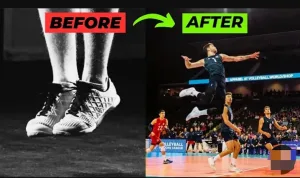
Below are some tips that we emphasize in our volleyball camps to help you increase your vertical jump.
Tip #1: Assess Your Starting Point
To begin, it’s important to know your baseline. Stand next to a tall wall with a sticky note in hand. Jump as high as you can and place the sticky note at your highest reach. Measure the distance from the top of the sticky note to the ground. Reassess your progress every two weeks to track your improvements.
Tip #2: Develop Explosive Power
Building explosive power is crucial for increasing your vertical jump. Start by practicing exercises that enhance your muscle memory. A great exercise is standing on a bench with one foot and hopping down, landing with both feet. As you land, immediately transition into a squat and then explode upwards into a jump. This drill helps you use the momentum from your descent to propel yourself higher.
Tip #3: Strengthen Your Lower Body
Resistance training is an effective way to boost your lower body strength. Incorporate exercises such as leg presses, Bulgarian split squats, calf raises, and deadlifts into your routine. Aim to use weights that allow you to complete 5-10 reps per set, gradually increasing the weight as you get stronger. Start with one session per week and slowly build this into your workout regimen to minimize the risk of injury.
Tip #4: Jump Rope Regularly
Jumping rope may seem simple, but it’s a highly effective exercise. It not only improves cardiovascular fitness but also helps increase calf muscle size. Incorporate 30-second intervals of fast-paced jump rope into your daily workout to see significant results.
Bonus Tip: Prioritize Stretching
One of the most effective ways to improve your vertical jump is through regular stretching. Stretching muscles like the hip flexors, which can become tight and restrict full muscle contraction, is crucial for making progress. Incorporate stretches like the butterfly, head-to-knee, sumo squat to stand, and figure 4 stretch into your routine. Using tools like a foam roller or lacrosse ball can help target specific tight areas. Stretching should be a regular part of your daily routine, not just something done before and after practices or games. By making stretching a priority, you’ll enhance your overall skill set, strength, injury prevention, and vertical jump.
Nutrition and Recovery: Essential for Jumping Higher
Proper nutrition and adequate recovery are just as important as your workout routine when it comes to jumping higher in volleyball. A balanced diet rich in protein, healthy fats, and complex carbohydrates will fuel your muscles and help with recovery. Additionally, getting enough rest allows your muscles to repair and grow stronger.
Example: Think of your body as a machine—if you don’t give it the right fuel (nutrition) and time to cool down and recharge (recovery), it won’t perform at its best.
Choosing the Right Footwear
Believe it or not, your choice of shoes can significantly impact how high you can jump. Volleyball shoes with thick, textured soles provide the necessary support and flexibility to help you push off the ground with greater force. Investing in a good pair of volleyball shoes is a small change that can lead to big improvements in your jump height.
Example: Professional volleyball players often opt for shoes designed specifically for the sport, which offer the right balance of cushioning and support, allowing them to jump higher with less effort.
See Also:
- Can You Wear Volleyball Shoes Outside?
- What is the Difference Between Volleyball Shoes and Basketball Shoes?
- Volleyball Shoes with Ankle Support: Expert Reviewed
- 8 Best Volleyball Shoes For Wide Feet
- Best Volleyball shoes, Review of different Volleyball shoes 2024
How to Jump Higher in Volleyball: Tracking Your Progress
As you work on improving your jump height, it’s essential to track your progress. Start by measuring your current jump height using a wall or a vertical jump tester. Record your height and set achievable goals. Reassess every few weeks to see how much you’ve improved and adjust your training as needed.
FAQs: How to Jump Higher in Volleyball
1. How long does it take to see improvements in my jump height?
Improving your vertical jump is a gradual process that requires consistent effort. Most players begin to notice improvements within 4-6 weeks of regular training. However, this timeline can vary depending on factors like your current fitness level, how often you train, and whether you’re incorporating proper technique and exercises into your routine.
2. What are the best exercises to improve jump height for volleyball?
The best exercises for increasing your jump height include plyometrics (like squat jumps and box jumps), strength training (such as squats, lunges, and calf raises), and flexibility exercises (like hamstring and hip flexor stretches). Jumping rope is also highly effective for boosting your jump height.
3. Can the right shoes really help me jump higher?
Yes, the right shoes can make a noticeable difference in your jump height. Volleyball shoes designed with thick, textured soles provide the necessary grip and support to help you push off the ground more effectively. This can add a few extra inches to your jump.
4. How can I prevent injuries while training to jump higher?
To prevent injuries, it’s crucial to warm up before workouts, incorporate stretching routines to improve flexibility, and gradually increase the intensity of your exercises. Additionally, make sure to wear proper footwear and avoid jumping on hard surfaces like concrete or asphalt. Lastly, listen to your body—if you feel pain, take a break to rest and recover.
5. Is diet important for improving my vertical jump?
Absolutely! A well-balanced diet provides the energy and nutrients your body needs to perform at its best and recover properly. Focus on eating a mix of protein, healthy fats, and complex carbohydrates. Staying hydrated and getting enough sleep are also key components of a good recovery plan, which will help you jump higher over time.
By following these tips and consistently working on your jump, you’ll see significant improvements in your vertical leap, making you a more formidable player on the volleyball court.

